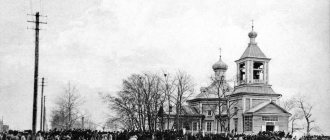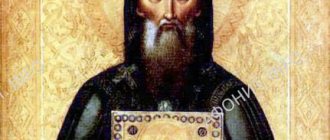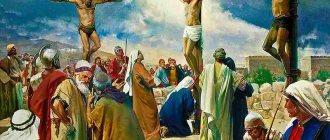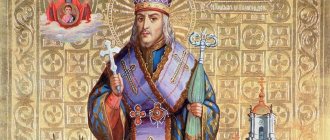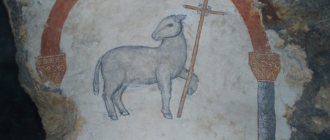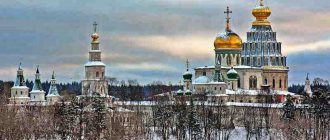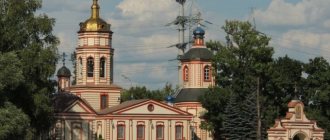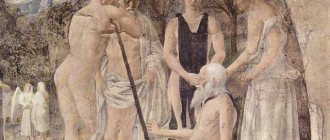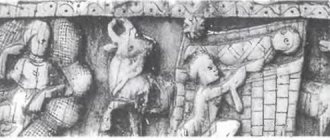Queen Helena is known to us from history as a saint by God's providence who found the cross on which Jesus Christ was crucified. They found it through her prayers and the prayers of Patriarch Macarius in Jerusalem. Queen Helena was sent to Jerusalem by the Emperor of the Roman Empire, her son Constantine. By order of Constantine, the First Ecumenical Council was convened. The Council compiled the Creed, which proclaimed once and for all the divine essence of Jesus Christ, who atoned for the sins of the human race at the cost of his crucifixion. The honorable cross on which Christ was crucified, the main Christian relic, was returned to the world by St. Elena and her son Konstantin.
Who was Queen Helen? What do we know about her life?
- Drepana was born in Turkey.
- She was the daughter of a hotel owner.
- She was married for love to the Roman warrior Constantius Chlorus.
- The couple had a son, Konstantin. This happened in 274. They were happily married for more than 18 years.
- Her husband was then appointed ruler of Galia, Britain and Spain.
- For such a generous gift, Emperor Diocletian demanded that he divorce his wife and marry the emperor's stepdaughter Theodora.
- At the age of 11, Elena’s son was taken away as a hostage of Constantius’s friendship with the emperor.
- Christian teaching becomes a joy and consolation for her. It was only when her son was proclaimed emperor that she was able to unite with him. The son loved his mother so much that he gave her the title of queen.
- Elena did not need power and honors. But she understood that her royal position would give her the opportunity to help spread the Christian gospel.
Helena raised her son, the future Roman emperor, with respect and love for Christianity. His peers, young men of wealthy families, despised Christianity and were brought up in the pagan faith.
The fruits of Elena's upbringing of her son were worthy. Issued by Emperor Constantine in 315, the Edict of Milan gave Christianity the status of state religion for the first time in the Roman Empire. Since then, Christians in Rome were no longer persecuted.
Meaning
On the icon most often St. Helen Equal to the Apostles is depicted with her son. Between them there is a cross. It's called the Icon of St. Equal-to-the-Apostles Constantine and Helena.
Days of remembrance of St. Helena - March 19 and June 3. She is canonized as an Equal-to-the-Apostles saint.
There are lists where only the holy queen herself is depicted, she is holding a cross in her hands. The cross symbolizes selfless devotion to the true Christian faith. The first icon of the saint was painted in the 4th century, and she was canonized almost immediately after her death.
Nail of the Crucifixion next to the power
“I was surprised to learn that the Assumption Cathedral of the Moscow Kremlin houses the most valuable relic of Christianity - one of the very nails with which Jesus Christ was nailed to the cross,” a resident of Voronezh wrote to the editor. It is known that the Kremlin is the center of Russian power, the residence of the president, heads of other states are met there, official events are held, but at the same time we know nothing about the Orthodox Shrines of the Kremlin cathedrals. Izvestia decided that this was wrong - it is interesting not only what is happening behind the Kremlin wall, but also unique Orthodox relics.
Peter I returned the Shrine
According to legend, the Nails were found in Jerusalem along with the Cross. Then they were brought to Constantinople. There are many legends associated with the relics. It is not even known exactly how many there were: 3 or 4. Catholics depicted the Crucifixion, on which both legs of Jesus Christ were nailed with one Nail, Orthodox - one on each leg. True, Catholic priest Evgeniy Henriks claims that this dispute applies only to art. How many Nails there were and where they are today is not known to Father Eugene, and, in his opinion, this does not matter: “Christians believe in the Lord Jesus Christ, in the fact that He was crucified and resurrected.”
It is believed that one of the Nails is kept in Notre Dame Cathedral in Paris, and the other in Milan Cathedral. There he is high under the arch, and he is lowered for worship only once a year.
As for the Nail from the Assumption Cathedral of the Kremlin, it ended up there in the 17th century. According to legend, Emperor Constantine sent it to the Georgian king Miriam, who converted to Christianity. The nail was kept by the Georgian kings. In 1688, one of them - Archil Vakhtangovich - moved to Moscow and took the Shrine with him. But when an epidemic broke out in Georgia, he was asked to return the relic. However, near Kazan, the messenger who was carrying the Nail was detained by the governor. By decree of Peter I, the Shrine was sent back and, together with the golden ark, was transferred to the Assumption Cathedral. On July 10 (old style), on the day of the Placing of the Robe of the Lord, in Moscow the Nail on the lectern was decorated with fresh flowers. But there was no special holiday for finding the Nail.
Today the Nail is a museum exhibit. So you can’t kiss him. It has been shown “live” twice over the past 8 years: in 2000 at the exhibition “Christian Relics of the Moscow Kremlin” and in 2004 in the Nikolo-Ugreshsky Monastery - on the occasion of the 625th anniversary of the monastery. The Nail is constantly located in the altar of the Assumption Cathedral.
The Robe of the Virgin Mary saved Constantinople
A part of the Robe of the Virgin Mary is also kept there. And, unlike the Nail, it is taken out for worship by believers. This happens on July 15 (July 2, old style) - the day of the Placing of the Robe. The Robe itself was found during the time of the Byzantine emperor Leo the Great and brought to Constantinople.
The chronicles say that the Mother of God more than once saved the city to which she bestowed her Robe from invasions. In 626, the capital of the empire was besieged by the Avars, in 717 by the Arabs, and in 860 by the Russians under the leadership of Prince Askold. Then the residents took the Holy Robe of the Mother of God, taken from the Blachernae Church, with a religious procession around the city walls, immersed its edge with prayer in the waters of the Bosphorus, and then transferred it to the center of Constantinople - the Church of Hagia Sophia. The Russians left with a large ransom. But the prince was soon baptized with the name Nicholas and invited Saints Cyril and Methodius, the creators of Slavic writing, to Rus'. Thus, it is believed that with the blessing of the Mother of God and the miracle from Her Holy Robe, not only the salvation of Constantinople from the most formidable siege in its entire history took place, but also the salvation of the Russians from the darkness of pagan superstition to eternal life. True, Askold was killed, and the pagan Prince Oleg seized power. The one who then “accepted death from his horse.”
At the end of the 14th century, part of the Robe of the Mother of God was transferred from Constantinople to Rus' by St. Dionysius, Archbishop of Suzdal. The Robe of the Mother of God is associated with the deliverance of Moscow in the summer of 1451 from the invasion of the Tatars under the leadership of Tsarevich Mazovsha, and military successes - the capture of Astrakhan in 1554 and the victory of Boris Godunov over the Crimean Khan Kazy-Girey. But the part of the Robe that you see in the photo was donated to the Assumption Cathedral by Prince Vasily Golitsyn in 1689. And the fate of the part of the Robe brought by Saint Dionysius, which was kept in the Annunciation Cathedral, is now unknown.
Miraculous icons and relics
In Constantinople, in the Church of Blachernae, where the Robe of the Mother of God was kept, there was also an icon of the Mother of God of Blachernae. She was found in Jerusalem. With this icon, Patriarch Sergius (610-631) walked around the walls of Constantinople with prayer services during the siege of the capital by the Avars in 626. After the fall of the capital of Byzantium in 1453, it was moved to Athos. And then it was presented by the Athonite monks to Tsar Alexei Mikhailovich. Now she is in the Assumption Cathedral.
The sacristan of the Kremlin cathedrals, priest Vyacheslav Shestakov, told Izvestia:
— On the day of celebration of the Blachernae Icon and the Icon of the Mother of God “Gracious Heaven,” located in the Archangel Cathedral, one is blessed to venerate them.
The celebration of the Blachernae icon is July 20 according to the new style, and the “Blessed Heaven” icon falls on March 19.
“...And only before the tomb / I said a quiet prayer, / My eyes began to see; I saw / And God’s light, and a grandson, and a grave” - this is how Pushkin’s “Boris Godunov” sounds like a story about a miracle that happened at the grave of Ivan the Terrible’s son, Tsarevich Dimitri, who was killed in 1591. According to the poet, Prince Shuisky then opposed the transfer of the relics of the prince from Uglich to the Kremlin. But after the death of False Dmitry I, when Shuisky himself became king, he changed his opinion. On July 15, 1606, the remains of the prince were solemnly transferred and placed in the royal tomb - the Archangel Cathedral of the Moscow Kremlin. Many healings took place at his relics, especially for patients with eyes. Demetrius was canonized. He was glorified as a martyr - more precisely, a passion-bearer. So the holy noble prince Dimitri is considered an intercessor against civil strife. The shrine with its relics is opened once a year - on Memorial Day, May 28 (May 15, old style), and you can venerate the relics.
The Archangel Cathedral contains the relics of Prince Mikhail of Chernigov. He is known for trying to persuade the European powers to collectively resist the Tatar-Mongol invasion. His words were not heeded. Not only Rus' was destroyed. Poland and Hungary were affected. The Ark with its relics is taken out for veneration by believers every year on October 3.
The relics of most Moscow high priests rest in the Assumption Cathedral.
Entry by invitation only
You can see icons in the Kremlin cathedrals during excursions. But only participants in divine services can venerate them and venerate other shrines of the Kremlin cathedrals. They are not held often. For example, in 2008, 19 services are planned in the Assumption Cathedral, 6 in Arkhangelsk and one each in the Cathedral of the Twelve Apostles, the Annunciation and the Church of the Deposition of the Robe. Entry is by invitation only. As priest Vladimir Vigilyansky, press secretary of the Moscow Patriarchate, told Izvestia, these tickets are not sold either on the streets or at the box office. They are distributed through the dean fathers of the Moscow diocese to parishes. Father Vladimir recommends that residents of other dioceses and representatives of organizations apply for tickets to the office of the Moscow Patriarchate.
The story of St. Helena finding the cross
Elena, at the age of 80, came to Jerusalem with the goal of finding the cross of the Lord in the places of execution and burial of Jesus Christ. They looked for him for a long time. Through the prayers of Helen and Patriarch Macarius, they found at the site of the destruction of a pagan temple dedicated to Venus. This happened in 326. We found three crosses, 4 nails and a sign with the inscription “INRI”. Translated into Russian - “Jesus of Nazareth. King of the Jews."
Which cross is the shrine? To find out this, a prayer service was served. Then all three crosses were applied to the deceased person. The cross from which he resurrected was recognized as the cross of the Savior.
Elena was the first to worship before the shrine and venerate it. Pilgrims visiting the Church of the Exaltation of the Holy Cross to see the place where the cross was found are also shown the Eleninsky window. According to legend, Elena was there during excavations day and night. She threw gold coins to inspire workers to do righteous work.
People wanted to see the found cross. Patriarch Macarius and Queen Elena erected the cross of the Lord for everyone on an elevated place so that people could worship it. This is how the important church holiday of the Exaltation of the Holy Cross arose. It is celebrated on September 27th.
She lived for another two years on the holy land and supervised the restoration of holy places.
Queen Helena erected temples in the holy places of Palestine. The Church of the Resurrection and the Holy Sepulcher, in which the Holy Fire descends every year on the holy Easter night. At the birthplace of Jesus in Bethlehem.
At the Oak of Mamre, where three angels appeared to Abraham in Hebron. At the site of the ascension of Christ, on the Mount of Olives. Church of the Assumption of the Virgin Mary in Gethsemane. Elena also founded monasteries, in which she invariably left a piece of the acquired shrines. And now these temples are the most sacred for the entire Christian world
Mysterious nails
Internationally renowned Tel Aviv University anthropologist Israel Hershkovitz received the nails in an unmarked box from the collection of Israeli anthropologist Nicu Haas, who died in 1986. According to the Israeli publication Haaretz, citing the Israel Antiquities Authority, Haas allegedly took them from a tomb excavated back in the 1970s, therefore, a couple of decades before the tomb of Caiaphas was found.
It is extremely important for archaeologists to know exactly where, when and how certain artifacts were discovered. Otherwise, it is easier to suspect a cleverly crafted fake than a genuine find.
The Israel Antiquities Authority records that two iron nails were found in the tomb of Caiaphas, one inside an unmarked ossuary, the other on the ground next to an ornate ossuary, but they were later lost.
Documentary filmmaker Simcha Jacobovici, in his controversial documentary The Nails of the Cross, suggested that nails were lost from Caiaphas's tomb: the high priest may have been so filled with guilt over Jesus' crucifixion that that he kept the nails either as a keepsake or for magical rituals.
How does St. help? Elena
People turn to the image of the saint for:
- help in important matters;
- with a request for career growth;
- solving issues of material well-being;
- about maintaining peace and prosperity in the family;
- assistance in childbirth;
- in raising children;
- about increasing yields.
People whose profession is connected with the highest government positions should seek prayerful help from Queen Helena and her son, Emperor Constantine.
Queen Helena is the patroness of missionaries and philanthropists, all of whom selflessly serve to spread and preserve the faith of Christ.
Prayer 1
About the wonderful and all-praised king, the holy Equal-to-the-Apostles Constantine and Helen!
To you, as a warm intercessor, we offer our unworthy prayers, for you have great boldness towards the Lord.
Ask Him for the peace of the Church and prosperity for the whole world, wisdom for the ruler, care for the flock for the shepherd, humility for the flock, desired peace for the elders, strength for husbands, beauty for women, purity for virgins, obedience for children, Christian education for babies, healing for the sick, reconciliation for those at war, patience for the offended, those who offend the fear of God.
To those who come to this temple and pray in it, a holy blessing and everything useful for each request, let us praise and sing the Benefactor of all God in the Trinity of the glorified Father, and the Son, and the Holy Spirit, now and ever and unto ages of ages. Amen.
